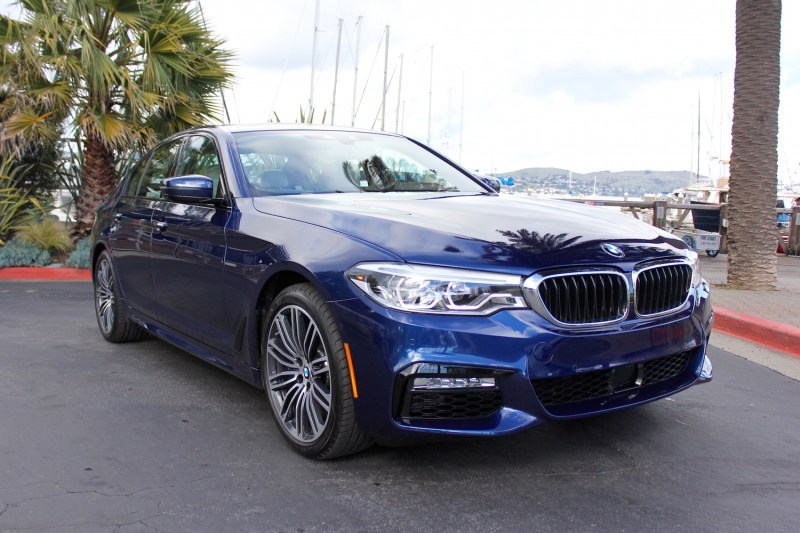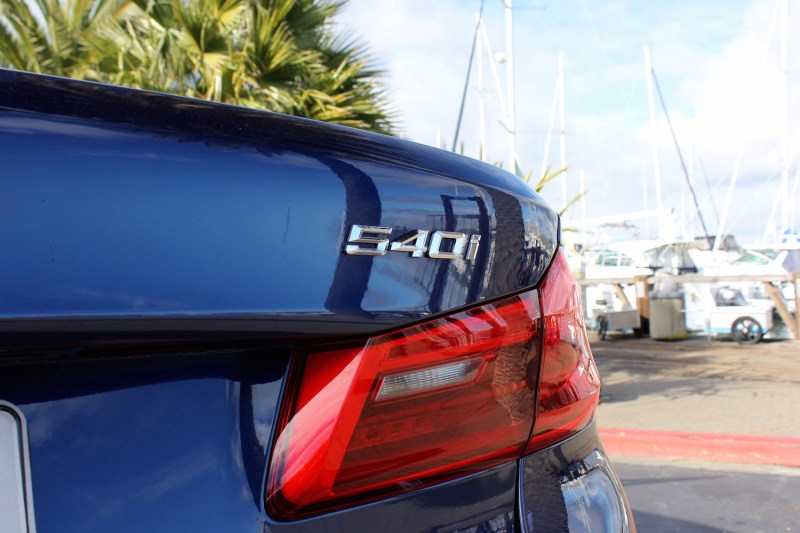It’s hard to remember a time when one could consider BMW a “rebel” in the premium car market, but the late ‘90s saw the German automaker producing vehicles that were unlike any competitors. While Audi, Lexus, and Mercedes-Benz defined the word “luxury” with interior comfort and ride quality, BMW viewed the concept through a performance lens.
No vehicle in BMW’s 90’s-era product portfolio was a better example of this than the E39 5 Series. Until the E39, midsize luxury sedans just weren’t all that sporty. Instead of building a luxury car with a dash of driving engagement, BMW crafted a performance machine with handsome looks and a plush interior. Before long, BMW’s rivals had re-tooled their midsize offerings to better compete, but not before the German automaker had stamped its badge on the segment.
Fond memories of the E39 and E60 5 Series made it all the more painful to drive the current generation. Rounded and uncharismatic, the luxury car was only redeemed by M’s performance tuning. Had BMW abandoned the segment it created? I was becoming convinced we’d never see another enthusiast 5 Series…but then I drove the new one.
Good Bones
The first indicator of BMW’s renewed performance mindset requires an x-ray scan of the sedan’s figure. An all-new platform is constructed from aluminum, magnesium, and high-strength steel for a total weight savings of 137 pounds compared to the outgoing model. Though I can’t help but wonder how much weight could be salvaged from a carbon core like the flagship 7 Series, the new 5’s architecture is noticeably lighter on its feet as-is.

Complementing the featherweight foundation is a re-tuned suspension and adaptive dampers. With three drive modes: Sport, Comfort, and Eco Pro, the 7th generation 5 Series can transform from cruiser to carver in fractions of a second. BMW’s Integral Active Steering (IAS) returns as an option for 2017, combining variable-ratio steering with rear-wheel pitch (in opposing direction to the front wheels at low speeds and in the same direction at higher speeds). Though I’ve had seat time in other vehicles with rear-wheel steering, I’ve yet to adjust to the sensation of a car’s aft pivoting mid-corner. It feels a bit like my butt is on skates. Discomfort aside, even acute corners feel much less challenging with the active rear wheels.
Feedback from the electronic steering rack is minimal, but artificial communication is commonplace in modern vehicles; I’m far more concerned with responsiveness and natural weight. A beefy M-sport steering wheel feels a tad light on center, but instantly becomes heavier with steering input. Responsiveness isn’t quite telepathic, but wheel movements are express delivered to every tire and respond faster with more steering effort.
At launch, the 2017 5 Series will be offered with two engine options: a 2.0-liter twin-turbocharged four-cylinder making 248 horsepower and 258 pound-feet of torque or a 3.0-liter twin-turbo inline six-cylinder delivering 335hp and 332 lb-ft of torque. The smaller engine improved 8 horses over the outgoing entry model while the straight six gains 35 ponies. Both powertrains are mated to an eight-speed automatic gearbox and can be configured with xDrive all-wheel drive (rear-wheel drive is standard).
More power and less weight mean both the 530i and 540i are quicker to 60 mph than their predecessors (528i and 535i), but the 530i still needs a bit more grunt. 248hp feels mighty in a compact sport sedan, but timid in a midsize vehicle. The 540i, meanwhile, is astonishingly rapid. Seemingly long distances between curves along Northern California’s route 116 simply disappear as I dig deeper into the 540i’s powerband. Both the 530i and 540i make quick work of a twisty road, but the more potent variant is a better representation of BMW’s performance charisma.
Practical Innovation
BMW once again looked to its 7 Series for design inspiration throughout the new 5’s cabin. As we’ve come to expect from the automaker, minimalist styling communicates luxury far better than glitzy chrome or flowing shapes. Wood and metal intertwine along the dashboard and center stack. Available Mocha Napa leather interior with white piping contrasts the wood beautifully and adds intrigue to an otherwise toned down cabin.

In addition to subtle design updates, the 5 Series borrows many advanced technologies from its flagship sibling, including gesture control, a 10.25-inch touchscreen infotainment system, and digital instrument cluster. Unlike its competitors, BMW blends analog and digital functions within the instrument panel, creating a unique visual effect. The infotainment, on the other hand, is fully contemporary. A crystal clear display houses interactive, customizable “tiles” that show real-time traffic, weather, telemetry, media, and navigation info. These tiles can be moved to prioritize whichever data the driver finds most useful.
Though BMW’s gesture control has been called “gimmicky,” I found the volume and muting signals to be useful and second nature after an hour or so behind the wheel. True, the functions are limited, and some of them are awkward to perform, but I expect this tech. will help reduce distraction and become even more intuitive over time.
By far one of my favorite features of the new 5 Series’ cabin is the revamped head-up display. 75-percent larger than before, the full color display is the best I’ve seen. Turn-by-turn navigation instructions are prominent, speed limits are noted in the bottom corner (whether you choose to abide by them is a different story), and current speed and gear display front-and-center.
Driver assistance features have been improved and fleshed out further for 2017. Lane keeping assist is smarter than ever before, adapting to curves in the road faster and reducing the ping-pong overcorrection between the lane lines. BMW says drivers can now keep their hands off the wheel (effectively letting adaptive cruise control and lane keeping assist fully pilot the car) for over 30 seconds; Digital Trends clocked 44 seconds of hands-free time before the system demanded human intervention. By comparison, the Mercedes-Benz E-Class requires a firm grasp of the steering wheel in shorter intervals.
BMW also touts Amazon Alexa integration, Apple CarPlay, a Bowers & Wilkins premium audio system, remote 3D view (letting you keep an eye on your car via a smartphone app), self-parking (parallel and perpendicular with a driver at the wheel), and remote parking (forward and reverse via the key fob). These innovations put the new 5 Series on equal footing with the highly advanced 2017 Mercedes-Benz E-Class, but BMW’s tech feels more intuitive. Multiple redundancies and logical layouts make accessing the car’s best features simple.
Mellow Makeover
Interestingly, the 2017 5 Series’ exterior design traits are the least compelling part of the vehicle. However, that doesn’t mean the styling tweaks don’t improve the car’s look. Subtle reshaping of the front and rear fascias, new LED headlights and taillights, and a twin-character line along the car’s profile distinguish the 7th generation model from its predecessor, but the average buyer might miss the differences.

The main thing to note is that this new 5 Series looks sharp – far more so than the current car. Slight though the exterior updates may be for a whole new generation, they combine for a sleek stance. It probably wasn’t BMW’s intention to put styling so far back among the midsize sedan’s best qualities, but this reality is actually positive in this humble reviewer’s position. The 5 Series is once again about driving pleasure, with a comfortable, high-tech interior thrown in for good measure.
Our Take
BMW’s 5 Series sedan is the beating heart of its brand positioning. Entry-level models are a taste of luxury and performance; flagship vehicles are the unobtainium we all desperately wish to grasp; mid-range cars like the 5 Series sit at the center of consumer desire. I can go on for hours about how BMW needs to refocus its whole portfolio on performance, but that won’t stop the automaker from selling countless units of coupe-this and crossover-that. Instead, I’ll speak to the favor I find myself casting on the 2017 5 Series. This new sedan redeems the flub of a product that is the current car. Sharper, lighter, more engaging, and infinitely more innovative, the 7th generation 5 Series is a luxury authority once more.
BMW’s 2017 5 Series competes directly with the Audi A6, Lexus GS, Jaguar XF, Cadillac CTS, and Mercedes-Benz E-Class. Hyundai’s newly formed Genesis brand and its G80 has also become worthy of consideration. Volvo’s brilliant S90 is yet another worthy contender.
As the first two variants in the 7th generation 5 Series lineup, the 530i and 540i won’t receive updates anytime soon. That said, look for additional variants to go on sale in April, including the 530e iPerformance plug-in hybrid and M550i twin-turbo V8 model. For the first time, BMW’s plug-in model will be the cheapest 5 Series you can buy (after federal and state tax incentives). For the best range of any 5 Series, a carpool green-sticker for California residents, 530i-rivaling 0 to 60 mph performance, many buyers may want to hold out for the 530e iPerformance. On the other end of the spectrum, BMW’s upcoming M550i xDrive will be quicker to 60 mph than the current M5 and will cost a relatively affordable $72,100. Due to production schedules, both the 530e and M550i will be 2018 model year vehicles.
Luxury car shoppers who haven’t fallen victim to the crossover’s siren song have plenty of choices in the midsize sedan segment. Selecting the right car will depend on your priorities – styling, comfort, technology, or performance. The 2017 5 Series is sufficiently stylish, but truly great when it comes to ride quality, convenience features, and performance. With it’s slight power deficiency, it’s harder to recommend the 530i ($51,200), but the 540i ($56,450) is very much class-leading. You’ll need remarkable self-control to avoid turning a $50K car into a $70K one with options, but prudent shoppers will appreciate the new 5’s value proposition.













